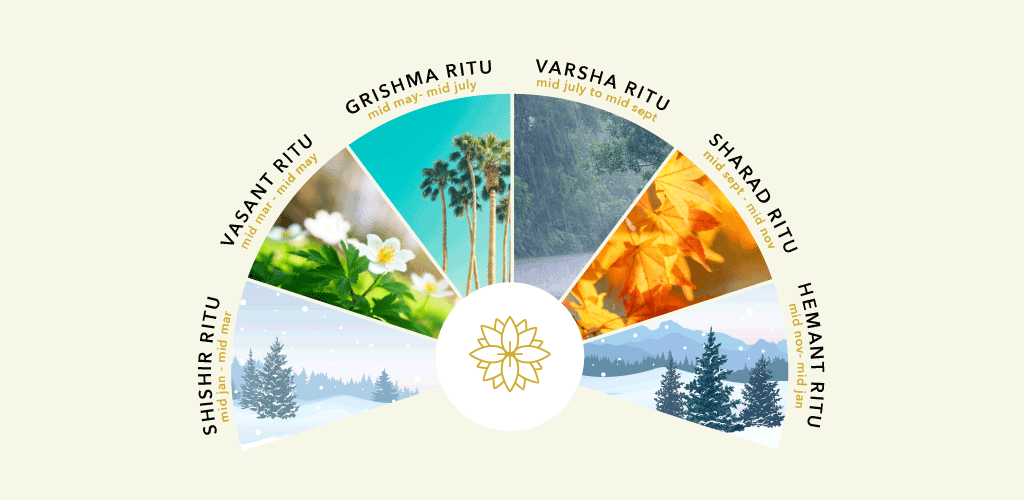
There's a reason why eating in season is so powerful. When you eat seasonally, you’re ingesting foods at their peak freshness with the highest nutritional value. Additionally, you’re contributing to the environment by eating what naturally grows during a certain time of year. This supports local farms and limits the transport of food coming from other places, which in turn reduces pollution.
Eating in accordance with Ayurveda is all about maintaining an already healthy state. Ritucharya is the name of this practice and can serve as a preventative health method focusing on changing your lifestyle and diet according to the seasons. After all, you probably wouldn’t want a cup of hot soup in the summer or a scoop of ice cream in the middle of January. Following Ritucharya stabilizes our doshas and helps us live optimal lives. Seasonal changes affect us mentally and psychically, and adapting to these changes also strengthens our bond with nature.

Ritucharya in Ayurveda
Ritucharya is a combination of two words: ritu meaning “season,” and charya meaning “guidelines.” As seasons change, we change. With Ritucharya, seasonal guidelines help create recommendations for diet and lifestyle. Ritucharya is a great way to build immunity and align yourself with the natural world.
Doshas in Ayurveda
Doshas are the energies that influence the body as a whole, and we all have them. Usually one dominates, but doshas vary in amount from person to person and can get thrown off balance. They’re structured around the five elements – fire, water, earth, air, and space or ether.
Ayurveda supports the idea that the body, mind, and spirit are integrated within the natural world. “According to Ayurveda, the doshas control the creation, maintenance, and breakdown of bodily tissue and elimination of wastes, as well as psychological aspects, such as emotions, understanding, and love.” To balance all three doshas, Vata, Pitta, and Kapha, understanding what foods work best with each is a good start. Ritucharya also helps keep doshas stable.
 |
Vata: represented by air and spaceWhen imbalanced, symptoms include joint pain, muscle aches, insomnia, dry skin, and constipation. Eating what's best will change through the seasons but warm, soft, and heavy foods are generally recommended. Qualities: creative, optimistic, moves quickly through life |
 |
Pitta: represented by fire and waterWhen imbalanced, symptoms include irregular periods, acne, diarrhea, indigestion, irritability, and gas. Fresh, cool foods are best for Pitta. Think spinach, watermelon, pineapple, stone fruit, and avocados. Qualities: hard-working, problem solver, ambitious, competitive |
 |
Kapha: represented by water and earthWhen imbalanced, symptoms include nausea, bloating, fluctuations in weight, congestion, and fatigue. Kaphas should eat dark leafy greens, bitter, dry foods, and cauliflower. It’s best to avoid nightshades. Qualities: calm, consistent, stable, dependable, protective |
Ayurvedic Seasons
There are six seasons in the Ayurvedic calendar. They are broken into two Kaals, or periods. Each one has three seasons.
Adaan Kaal/Northern Solstice/Uttaryana (Jan 14-July 14), also known as the cold months.
Winter: Shishir Ritu - mid-January to mid-March
Spring: Vasant Ritu - mid-March to mid-May
Summer: Grishma Ritu - mid-May to mid-July
Visarga Kaal/Southern Soltice/Dakshinayana (July 14-Jan 14), also known as the warm months.
Monsoon: Varsha Ritu - mid-July to mid-September
Autumn: Sharad Ritu - mid-September to mid-November
Late Autumn/Pre-Winter: Hemant Ritu - mid-November to mid-January
Ritucharya follows an Ayurvedic food list for each season.

Adaan Kaal/Northern Solstice/Uttaryana
Adaan means taking away/absorbing. The sun and wind are intense during this season. The sun absorbs energy from humans. bringing a cooling effect to the earth, making people feel weaker.
Shishir Ritu (winter)
Cold and rainy weather makes people less energetic. You're more likely to be hungry during this season. To provide the body with warmth, heavier foods should be eaten.
Suggested foods: grains like rice, corn, cereals, milk, milk products, asparagus, beets, garlic, ginger, and anything sour.
Lifestyle: exposing the body to sunlight, bathing in lukewarm water, and layering for warmth.
Vasant Ritu (spring)
As the sun begins warming the earth, new leaves and flowers start budding. Energy is in the middle range, and foods that can be easily digested should be eaten. Anything cold or too dense, sweet, or sour should be omitted.
Suggested foods: lentils, barley, bell peppers, cabbage, mushrooms, wheat, rice, and bitter foods.
Lifestyle: massages, exercise, and cleansing the body with warm water is very important.
Grishma Ritu (summer)
The strength of the sun dries up plants and water sources. This is the season of light eating. People have less energy than the season before. It’s best to avoid warm, pungent, and sour foods during the summer.
Suggested foods: lots of water, fruit juices, zucchini, snow peas, cucumbers, buttermilk, and oats.
Lifestyle: Napping during the day and staying cool should be considered. Alcohol consumption and sexual indulgences should be avoided.

Visarga Kaal/Southern Solstice/Dakshinayana
Visgara translates to giving. During this second half of the year, the sun is showering the earth with energy. People are more lively and positive.
Varsha Ritu (monsoon)
Rain pours from the sky, filling the earth with water. Strength becomes weaker now, and salty, sour foods should be eaten.
Suggested foods: boiled water, soups, wheat, and barley. Meat and foods that are tough to digest shouldn’t be eaten during this time.
Lifestyle: Using hot water to bathe and massaging the body with oil are recommended.
Sharad Ritu (autumn)
The sun starts making an appearance after the rainy season, illuminating the earth. The skies are open and white clouds appear with damp mud on the ground. Sharp, sweet foods should be added, while astringent, fatty foods should be taken away. Strength is at a medium.
Suggested foods: wheat, quinoa, potatoes, root veggies, eggplant, apples, and dates.
Lifestyle: only eating when hungry, bathing in the moonlight, and restorative health practices can be done, i.e. acupuncture.
Hemant Ritu (pre-winter)
It gets colder as winds intensify. A person has the highest energy in this season. Sweet, salty, and sour foods are to be incorporated.
Suggested foods: meat, fatty foods, fermented foods, pumpkin, apples, sesame, nuts, and seeds. Your diet should contain heavier foods and eliminate light, cold, and dry foods.
Lifestyle: head and body massages, exercising, bathing in warm water, and monogamous sex.
Try It!
Some of this may seem confusing or restrictive but don’t let that intimidate you. Following every formula to the T may not completely work for you. However, being aware of how you change through the seasons and putting in a little effort to match aspects of your life with them may have a positive impact that’s worth trying.
*As always, it’s important to contact your physician before making any changes that could impact your health.

Lilith Mesidor
Lilith is originally from The Hudson Valley in New York. Growing up in this area made it easy to access the outdoors, and having a healthy, active lifestyle has always been natural to her. Her sense of adventure and curiosity has taken her around the globe, shaping her perspective on life and human connection.
After graduating from SUNY Purchase College in Westchester, NY, she moved to Brooklyn. From there, she got bit by the travel bug and spent three years traveling on and off all over the world, using NYC as her base. She backpacked solo through South America, Eastern Europe, Southeast Asia, and parts of the Middle East. After returning from a year-long stint overseas, she moved to Aspen where she spent a winter season on the slopes.
Lilith sees the value of art and incorporates it into her life by doing or seeing at least one artistic thing a week. When she's not geeking out over health and wellness, she can be found checking out a new restaurant, seeing live music, and petting every dog she sees walk by.
She currently resides in beautiful, sunny Los Angeles.